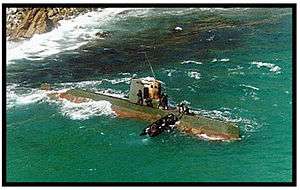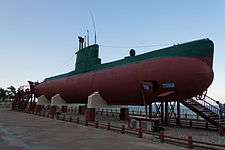1996 Gangneung submarine infiltration incident
The 1996 Gangneung submarine infiltration incident occurred on September 18, 1996, near the South Korean town of Gangneung. The incident was one of the more serious instances of North Korean espionage involving the Reconnaissance Bureau (reconnaissance team and 22nd Squadron of the Maritime Department of the Reconnaissance Bureau).[2]
| Infiltration of Gangneung | |||||||
|---|---|---|---|---|---|---|---|
 The Sang-O-class submarine stranded on the South Korean coast | |||||||
| |||||||
| Belligerents | |||||||
|
|
| ||||||
| Strength | |||||||
| 43,000 personnel |
1 Sang-O-class submarine 26 personnel | ||||||
| Casualties and losses | |||||||
|
12 killed
|
24 killed
1 missing 1 submarine captured[1] | ||||||
| 4 South Korean civilians killed[1] | |||||||
History
Landing
In 1996 on September 15, a North Korean Sang-O-class submarine landed a three-person special operations reconnaissance team on the east coast of South Korea near Jeongdongjin, 20 kilometres (12 mi) south-east of Gangneung, Gangwon-do. Their mission was to spy on the naval installations in the area and then return.
The submarine made a failed attempt to collect the team on the 16th and returned the following day. It ran aground in the attempt, and all efforts to free her were unsuccessful.
The crew then decided to destroy the sensitive equipment in the submarine and try to make it to the DMZ. The crew split up in several groups but one was soon spotted by a civilian who became suspicious and alerted the authorities, who quickly mobilized.
South Korean manhunt
A 49-day-long manhunt ensued, from 18 September through 5 November, resulting in the capture or elimination of all the crew and members of the reconnaissance team, except one, who is believed to have made it back to North Korea. Four civilians and 12 South Korean soldiers (eight KIA and four in accidents) died; 27 soldiers were wounded.
Of the 25 North Korean infiltrators, one was captured, 11 were killed by the other members for failure in responsibility of running aground of the submarine, and 13 were killed in firefights with the South Korean Army. Some analysts suspected that the motivation behind the assassination of Choe Deok-geun, South Korean consul for the Russian Far East, was North Korean retaliation for the loss of their men.[3][4][5]
The infiltrators possessed among their arsenal M16A1 rifles and imitation South Korean-style military uniforms.[6][7] Nestlé Crunch chocolate bars were also recovered.[8]
Some of the dead spies' corpses were displayed to the media;[9] some were wearing South Korean-style military uniforms as disguises.[10]
The submarine was salvaged and towed to a naval base for investigation. The sole captured crewmember, the submarine's helmsman, Lee Kwang-soo, gave in after much interrogation and revealed much of the plans. He later became an instructor in the South Korean Navy.
North Korea was at first reluctant to take responsibility, claiming that the submarine had suffered an engine failure and had drifted aground. By 29 December, however, the North issued an official statement expressing "deep regret" over the submarine incident.[1] In return, the South Korean government returned the cremated remains of the infiltrators to the North via Panmunjom on 30 December.
Timeline of North Korean casualties
- September 18, 16:40 – 1 captured by local policemen
- September 18, 17:00 – 11 bodies of executed submarine crew members were found
- September 19, 10:00 – 3 killed by the South Korean army commandos
- September 19, 14:00 – 3 killed by the South Korean army special forces
- September 19, 16:00 – 1 killed by the South Korean army
- September 21, 20:00 – 1 killed by the South Korean army
- September 22, 06:00 – 1 killed by the South Korean army
- September 28, 06:30 – 1 killed by the South Korean army
- September 30, 16:00 – 1 killed by South Korean special forces
- November 5, 10:00 – 2 killed by South Korean special forces
Aftermath

The Sang-O class submarine is on display at Tongil (Unification) Park near Gangneung.
See also
References
- "North Korea apologizes for submarine intrusion". CNN. 29 December 1996. Retrieved 8 December 2012.
- "In 1996, a Dead North Korean Spy Submarine (Armed with Commandos) Nearly Started a War". Center for the National Interest.
- "North Korea denies murdering diplomat", CNN, 1996-10-04, retrieved 2007-06-01
- Jeong, Hoe-sang (1996-10-17), "최덕근 영사, 러시아 마피아가 살해했다?/Consul Choe Deok-geun, killed by the Russian Mafia?", Sisa Journal, retrieved 2007-06-01
- Bertil, Lintner (2002). Blood Brothers: Crime, Business, and Politics in Asia. Allen and Unwin. pp. 213–214. ISBN 1-86508-419-0.
- "A Weapon Displayed From North Korea Special Forces and their Submarine". MBC News. 25 September 1996.
- "Equipment of North Korean Special Forces and Espionage". Yu Yong-won's Military World, Chosun Ilbo. 16 April 2013.
- "SOUTH KOREA: SUBMARINE INVESTIGATION". YouTube. Retrieved 7 January 2019.
- "SOUTH KOREA: GUN BATTLES FOLLOW NORTH KOREAN INFILTRATION ATTEMPT". YouTube. Retrieved 7 January 2019.
- "r/MilitaryPorn - 1996 Gangneung submarine infiltration incident". Reddit.com. Retrieved 7 January 2019.
Bibliography
- Harry P. Dies, Jr.: North Korean Special Operations Forces: 1996 Kangnung submarine infiltration, Military Intelligence Professional Bulletin, Oct-Dec 2004.